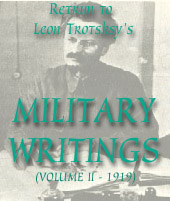
The former Cossack colonel Mironov[For the background of the Mironov affair and Mironov’s subsequent Career, see Mironov’s Last Letter, in Samizat Register 1, edited by Roy Medvedev (Merlin Press, 1977).] fought at one time in the Red forces against Krasnov. Mironov was motivated by personal ambition, aiming to become Ataman of the Don. When it became clear to the Cossack colonel Mironov that the Red Army was not fighting for the benefit of Mironov the careerist, but for the interests of the peasants and Cossack poor, Mirononv raised the banner of revolt. Having made contact with Mamontov and Denikin, Mironov succeeded in confusing a few hundred Cossacks, and is trying to force his way with them into the ranks of the ‘N’ division, so as to introduce confusion and betray the workers’ and peasants’ regiments to the counter revolutionary enemy.
As a traitor, Mironov is declared an outlaw. Every honourable citizen who encounters Mironov has the duty to shoot him down like a mad dog.
Death to the traitor!
Long live the alliance of the workers, peasants and working Cossacks!
Long live the honourable fighters of the ‘N’ division! [64]
64. The factual side of Mironov’s revolt is here described on the basis of the materials published by Comrade Smilga (Voyennoye Ocherki [Military Sketches], published by Ekvator), as follows. Mironov, a former Cossack colonel, formed after the October revolution a division of volunteers named after himself. There were no Communist cells in this division, and commissars were treated with suspicion. Mironov enjoyed much sympathy among the population of his native stanits of Ust-Medveditskaya and its neighbourhood. During the offensive in January-February 1919 he commanded group of two divisions which advanced ahead of the Ninth Army to the Northern Donets. Already at this time it became apparent that he was trying by means of demagogic procedures and agitation against local Party workers to win fame as the defender of Cossack interests against the Commnunist threat. Mistakes in our policy in the Don country provided him with rich soil for such demagogy. This obliged the high command to transfer Mironov to the Westem front. When Denikin’s successes began, the Revolutionary War Council of the Southern Front applied for Mironov to be appointed to command the Don Corps that was being formed at Saransk. From that moment Mironov began to behave very suspiciously, sent telegrams in the form of ultimatums to the Soviet Government, and made speeches at meetings in which he sharply protested against the policy of Comrades Lenin and Trotsky. In the middle of August, when the Southern front began its unsuccessful offensive towards Kharkov, and when Mamontov’s cavalry broke through at the junction between the Eighth and Ninth Armies and captured Kozlov and Yelets, Mironov decided, without authority from the command of the Southern front, to move up to the front, alleging that the Government was sabotaging the formation of his corps. Comrade Smilga tried to argue with Mironov, and summoned him to Penza, but nothing came of this, and on August 23 Mironov, having announced his decision to fight on two fronts (against Denikin and against the Bolsheviks), began to move his units towards the 23rd Infantry Division, which he had commanded and on whose support he counted. His forces consisted of about 4,000 men (of whom only 2,000 were armed), a thousand cavalrymen, two guns and ten machine-guns. Mironov’s calculation that the Cossack masses would join him proved unfounded. He was proclaimed a mutineer. To liquidate the revolt a combined force was formed, consisting of units from the First and Fourth Reserve Armies and the Samara Fortified Region, under the overall command of Comrade Goldberg. The first clashes took place on August 26. Mironov successfully evaded pursuit until he came up against Comrade Budyonny’s cavalry corps, which had been transferred from the Southern group of the Eastern front to help the Southern front. Within a few hours it was all over with the mutineers. Mironov and all the active participants in the revolt were sentenced to be shot, but the majority of them, including Mironov, were pardoned by a decision of the Presidium of the All-Russia Central Executive Committee. In the fight against Wrangel Mironov commanded the Second Mounted Army. In the winter of 1921 he was again arrested, in connection with the organisation of a revolt on the Don, and shot.

Last updated on: 27.12.2006